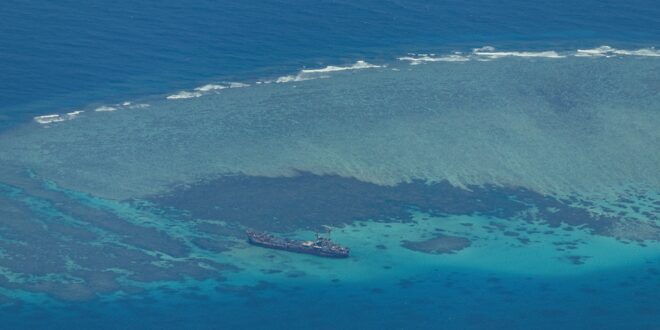Manila has fully allied with Washington amid increasingly dangerous standoffs with Beijing in the South China Sea, heightening the prospect of a wider war.
Why has the South China Sea become a source of contention in the region?
Chinese leader Xi Jinping has continually projected China’s strength abroad, particularly in Asia, most notably to safeguard Beijing’s “core interests,” which includes the South China Sea (known in the Philippines as the West Philippines Sea). The sea itself is not only strategically critical because of a wide range of potential regional conflicts, a major trade waterway, and vital to a possible war over Taiwan, but it is also one of the world’s richest sources of fish and a potential major source of untapped oil. Since late 2013, China has steadily reclaimed land and militarized its positions in the South China Sea in an attempt to legitimize its territorial claims. In recent years, Chinese Coast Guard boats and other military vessels have confronted other ships transiting the sea to deter other claimant states.
What’s behind the latest tensions between China and the Philippines?
In June, China’s Coast Guard brandished axes and other bladed weapons during a clash with Philippine manned vessels in the disputed Spratly Islands’ Second Thomas Shoal, an archipelago at the center of territorial disputes since the 1980s where there are now regular clashes between Chinese and Philippine forces.
Unlike other Southeast Asian states with territorial claims in conflict with China, which usually try to resolve disputes quietly with Beijing, the Philippines has openly bolstered its defense cooperation with the United States and publicly pushes back against China’s overlapping claims in the South China Sea. In late July, Washington and Manila signed an agreement containing $500 million worth of new defense aid to modernize the Philippine military and coast guard. The funding is meant to better equip the Philippine armed forces to counter Chinese activities in the South China Sea and increase the United States’ interoperability with Philippine forces. The Philippines has also built tighter defense ties with other major democracies, such as Germany and Japan, and some regional states, such as Vietnam, which has had repeated skirmishes with Chinese vessels in the Sea.
These steps have enraged China, which has increasingly harassed Philippine ships, often to the point of creating collisions or near misses between vessels by sailing close, ramming into them, or shooting water cannons at them, heightening the risk of injuries or death at sea. Analysts also note that areas for flash points are growing; Chinese and Philippine vessels collided in the Sabina Shoal in mid-August, marking the first time the two sides have clashed directly over the area. As the frequency and severity of these clashes have increased this year, the Philippines’ President Ferdinand Marcos Jr. stated that his country should “do more” to counter China’s “illegal actions.”
Map of South China Sea showing territorial claims by China, the Philippines, Vietnam and others.
Is the recent agreement between China and the Philippines likely to reduce conflict across the disputed sea claims?
Probably not. The two sides recently came to what was called a “provisional agreement” to allow the resupply of Philippine sailors stationed on a grounded naval vessel at the Second Thomas Shoal. The deal also establishes a presidential hotline for both sides to communicate during major maritime crises.
However, the relatively narrow deal is unlikely to reduce conflict, given that China has not relinquished its claims to the entire sea, and in the past, China did not pick up the phone when U.S. leaders called during a crisis. Beyond the hotline, China will not concede much, and Manila is already claiming that Beijing has mischaracterized the pact’s limited scope.
In the event of China escalating into military action, what obligations does the United States have to the Philippines as a treaty partner?
The United States has held a mutual defense treaty with the Philippines since 1951. In March, U.S. Secretary of Defense Lloyd Austin reaffirmed Washington’s commitment to its ally and clarified that the treaty extended to both countries’ armed forces, public vessels, and aircraft in the South China Sea. This means that the United States would be obligated to defend the Philippines if conflict escalated with China in the sea. Such escalatory scenarios could include:
China using naval vessels, not the Coast Guard, against Philippine ships;
China directly attacking and killing Philippine forces; and
An incident starting with an accidental clash between the two but that escalates into China attacking Philippine naval and coast guard vessels with deadly force. Unlike a decade ago, when there was a broad spectrum of opinions in Washington about how to deal with China, both Republicans and Democrats have generally settled on a bipartisan, hawkish approach toward Beijing—one mirrored by that of President Xi Jinping’s administration.
If former President Donald Trump is reelected, he has promised to take an even tougher stance toward China, including harsher economic measures that could severely impact the relationship, as well as a major build-up of U.S. forces in the Pacific. His approach could exponentially raise tensions in the sea and around Taiwan, and force not only the Philippines but also other claimant states, such as Malaysia and Vietnam, to choose sides.
If Vice President Kamala Harris wins the presidential election, she would likely continue the Joe Biden administration’s approach of courting regional states and trying to prepare for a wider conflict in the South China Sea.
How have the United States, the Philippines, and China attempted to reduce the likelihood of future conflicts from emerging?
Beyond the narrow pact Beijing and Manila recently agreed to strike, there have been few efforts to prevent conflicts from emerging and spiraling into broader, regional wars, and little indication that even these efforts have been successful. In April, President Biden reiterated the “importance of the rule of law and freedom of navigation in the South China Sea” on a call with President Xi, and the U.S. and Chinese militaries held talks on maritime safety a few days later.
As states with overlapping claims with China become more worried about Beijing’s power projection and feel they no longer can hedge between major powers, they are likely to step up their arms purchases and military modernization, as the Philippines is already doing. Some could also choose to more assertively confront Beijing, despite China’s regional economic dominance, by partnering with or buying more arms from the United States or other powers, such as Japan, which already is selling weapons to Southeast Asian states like Vietnam.
Other countries could openly side with China and rely on its military aid, as has occurred in Thailand, which is a Southeast Asian power albeit not a claimant to the South China Sea. Indeed, Southeast Asia has one of the fastest-growing levels of defense spending in the world; countries like Indonesia and Vietnam, which both have territorial claims in the sea, boosted their spending by more than 600 percent in recent years.
There appears to be little chance of a de-escalation of these tensions anytime soon. China’s belligerence and the continuing arms race—accelerated by growing sales from major powers, pressure on some countries from the United States, and rising fears among Southeast Asian states—heightens the risks of deadly confrontations or accidents. With the United States now having declared itself ready to defend the Philippines and few measures in place to reduce the temperature once confrontations have flared into bigger fights, it is not hard to imagine one incident turning into a much broader conflict.
Yet, as regional conflict specialist Oriana Skylar Mastro has noted, China’s position in the South China Sea is less secure than around Taiwan, and if the United States more assertively policed the sea, upgraded other regional defense ties, and made clear it would stand up to China in a fight, Beijing would probably back down from some of its aggression. That in itself might prevent conflict, at least for a time.
 Eurasia Press & News
Eurasia Press & News




